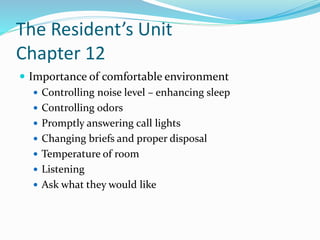
Chapter 12 The Resident’s Unit
- 1. The Resident’s Unit Chapter 12 Importance of comfortable environment Controlling noise level – enhancing sleep Controlling odors Promptly answering call lights Changing briefs and proper disposal Temperature of room Listening Ask what they would like
- 2. Standard Resident Unit Bed – Electric Bedside stand Personal items kept in stand Overbed table Call light Privacy curtain Keep tidy
- 3. Cleaning the equipment Bedpans BSC Urinals Use facility protocol for cleaning these Dirty utility room Clean utility room
- 4. Bedmaking Linens always changed after baths, when damp or soiled 3 other reasons to change linens… Wrinkled, bunched up linens may prevent good sleep May cause infection or disease (moisture - breeding ground for bacteria) Increase risk for pressure sores
- 5. Bed making guidelines Keep linens wrinkle-free, tidy Wash hands before handling clean linen Hold soiled linen away from body Do not shake Gloves for dirty linen (not in test, but in real life)
- 6. Occupied bed Review from learned skill Make resident comfortable Bed in low position Call light within reach
- 7. Definitions Closed bed – Completely made with bedspread and blankets in place Open bed – Blankets folded down ready to receive resident who has been out of bed or day or being admitted to facility Surgical bed – linens are folded to the side to receive resident from gurney, returning from procedure or test (hospital setting)
- 8. Personal Care Skills Chapter 13 Hygiene – practices to keep our bodies clean Bathing Brushing teeth Grooming – fingernails, hair Both, along with eating, transferring, and toileting are called ADLs (Activities of Daily Living)
- 9. Personal Care (continued) Encourage independence when possible Be professional at all times Always explain procedure Provide privacy Promotes dignity and respect Helping with personal care gives the opportunity to observe for changes: Skin, mood, pain, always make note and tell nurse
- 10. Personal Care (continued) Other things to observe for changes and report Skin color, temp, mobility issues, ability to perform own care (stand-by assist, 1 person assist, 2 person assist, etc) Complaints Mental and emotional state
- 11. Why do residents need help with ADLs? Chronic illness Frail – old age Disabled Dying What kind of help and with what? Bathing, peri care, toileting, mouth care, shampooing, combing-brushing hair, nail care, shaving,dressing, eating, walking, transferring. Often called a.m or p.m care. Why?
- 12. a.m. and p.m. care a.m. care Offering bedpan/urinal/trip to BR Wash face and hands Mouth care/denture care, before or after breakfast Dressing, deodorant, hair, make-up? Sometimes p.m. care Offering bedpan/urinal/trip to BR Wash face and hands Giving snack Mouth care Back rub…sometimes
- 13. Skin care Prevention is the key! Be aware of why and where skin breakdown can occur. Bony prominences and pressure Under breasts and scrotum (moisture) Ears Change position q 2h. (every two hours) Inspect areas of body at this time. If breakdown starting, inform nurse and place pillows, wash and dry area that is moist Place barrier cream
- 14. Signs of skin breakdown Pale, white, reddened Darker skin may look purple Tingling, burning If pressure allowed to continue, will become a “pressure sore”, “bed sore”, or “decubitus ulcer” Rash (under breast, scrotum, peri area)
- 15. Pressure Sores If left unattended, will get bigger, deeper, and infected Most pressure sores occur within a few weeks of admission to LTC Painful, difficult to heal. Can lead to life-threatening infections…so… PREVENTION IS THE KEY!!
- 16. 4 stages – See pg 196 Stage 1: Skin intact, but reddened, does not blanch or go away within 15 to 30 minutes Stage 2: Superficial ulcer. Blister or shallow crater…partial skin loss…outer or inner layer Stage 3: Full skin loss…death of tissue..extends down to tissue that covers muscle Stage 4: full skin loss, major destruction, damage to muscle, bone, or ligaments Takes a long time to heal…
- 17. Basic skin care Clean and dry Reposition at least every 2 hours Change soiled briefs often or at least every 2 hours, give good peri care Be careful during dressing or transfers especially with… People that are stiff and cannot move limbs well People who are on blood-thinning medications Encourage good nutrition and hydration
- 18. When moving in bed… Use draw sheet Do not slide resident – causes “shearing” using friction…can damage skin Use pressure relieving devices: Heel protectors Pillows Alternating pressure mattress Bed cradle ( toe pleat helps, too)
- 19. Pressure-relieving devices (continued) Also called “Positioning Devices” Hand rolls Orthotic devices: Splint Brace Knee pillows Other pillows (behind back, under arm, etc)
- 20. Bathing guidelines Complete bed bath Use mitt or 4 corners for face Provide privacy Cover with bath blanket Only uncover part being washed Place towel under limb being washed When washing face, wash from inner aspect to outer aspect of eyes Review steps on pg 200, 201, & 202
- 21. Modified Bed bath One of your skills Will wash face, one arm, and one hand Always place towel under part being washed (with the exception of face Wash, rinse, and pat dry for all bathing skills
- 22. More skills… Fingernail Care Foot care Mouth Care Cleaning dentures Peri-care – female and male Dressing affected side With all of these…provide privacy!
- 23. Other grooming skills… Shaving – always wear gloves! Electric disposable razor Flossing Shampooing hair Dandruff Lice Combing, brushing hair Review whole chapter thoroughly!